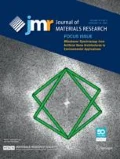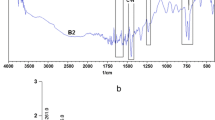Abstract
A large contrast ratio (>ΔΤ = 60%) and rapid switching (0.3–1 s) electrochromic (EC) polymer device that consists of a laminated two-layer structure between two electrodes was prepared. The new design consists of an indium tin oxide (ITO) glass electrode, a cathodic EC polymer film, a solid electrolyte, and a counterelectrode that replaces the anodic EC polymer and ITO electrode. Four EC polymers including two new EC polymers, Poly[3-methyl-3′-propyl-3,4-dihydro-2H-thieno(3,4-b)(1,4)dioxepine] (PProDOT-MePro) and Poly[3,3-diethyl-3,4-dihydro-2H,7H-(1,4)dioxepino(2,3-c)pyrrole] (PProDOP-Et2), were synthesized as cathodic EC polymers. A carbon-based counterelectrode was prepared for comparison with an Au-based counterelectrode. Several kinds of polymer gel electrolytes were prepared for comparison. The devices (windows) were increased in area from 0.028 × 0.04 in.2, 1 × 1 in.2 to 3 × 3 in.2 Three main components, the EC polymer film, the gel electrolyte, and the counterelectrode, were studied and their optical properties, conductivities, and repeatabilities were compared. The effects of window size on the contrast ratio, switching speed, power usage, and repeatability were studied.
Similar content being viewed by others
References
C. Xu, L. Liu, S. Legenski, M. Le Guilly, M. Taya, and A. Weidner: Enhanced smart window based on electrochromic (EC) polymers. Smart Structures and Materials 2003. Proceeding of SPIE. 5051, 404 (2003).
C. Xu, H. Tamagawa, M. Uchida, and M. Taya: Enhanced contrast ratios and rapid switching color changeable devices based on poly(3,4-propylenedioxythiophene) derivative and counterelectrode. Smart Structures and Materials 2002. Proceeding of SPIE. 4695, 442 (2002).
C.M. Lampert: Large-area smart glass and integrated photovoltaics. Solar Energy Mater. 76, 489 (2003).
D. Lundstrom and J. Yilbar: Liquid crystal materials: Experimental material physics. Available at http://www.kth.se/fakulteter/tfy/kmf/lcd/lcd~1.htm.
B.C. Thompson, P. Schottland, K. Zong, and J.R. Reynolds: In situ colorimetric analysis of electrochromic polymers and devices. Chem. Mater. 12, 1563 (2000).
S.A. Sapp, G.A. Sotzing, and J.R. Reynolds: High contrast ratio and fast-swiching dual polymer electrochromic devices. Chem. Mater. 10, 2101 (1998).
D.M. Welsh, A. Kumar, E.W. Meijer, and J.R. Reynolds: Enhanced contrast ratios and rapid switching in electrochromics based on poly(3,4-propylenedioxythiophene) derivatives. Adv. Mater. 11, 1379 (1999).
Y. Nishikitani, T. Asano, S. Uchida, and T. Kuba: Thermal and optical behavior of electrochromic windows fabricated with carbon–based counterelectrode. Electrochim. Acta. 44, 3211 (1999).
G.A. Sotzing, J.L. Reddinger, A.R. Katritzky, J. Soloducho, R. Musgrave, J.R. Reynolds, and P.J. Steel: Multiply colored electrochromic carbazole-based polymers. Chem. Mater. 9, 1578 (1997).
M. Lapkowski and A. Pron: Electrochemical oxidation of poly (3,4-ethylenedioxythiophene)—”in situ” conductivity and spectroscopic investigations. Synth. Met. 110, 79 (2000).
I. Schwendeman, J.H. Hwang, D.M. Welsh, D.B. Tanner, and J.R. Reynolds: Combined visible and infrared electrochromism using dual polymer devices. Adv. Mater. 13, 634 (2001).
A. Merz, R. Schropp, and E. Dotterl: 3,4-Dialkoxypyrroles and 2,3,7,8,12,13,17,18-octaalkoxyporphyrins. Synthesis 7, 795 (1995).
S.A. Agnihotry and S.S. Pradeep: Sekhon, PMMA based gel electrolyte for EC smart windows. Electrochim. Acta. 44, 3121 (1999).
L. Su, J. Fang, Z. Xiao, and Z. Lu: An all-solid-state Electrochromic display device of prussian blue and WO3 particulate film with a PMMA gel electrolyte. Thin Solid Films 306, 133 (1997).
L. Su, J. Fang, Z. Xiao, and Z. Lu: All solid-state elecrtochromic window of electrodeposited WO3 and Prussian blue film with PVC gel electrolyte. Thin Solid Films 320, 285 (1998).
S.S. Sekhon and S.A. Deepa: Agnihotry, solvent effect on gel electrolytes containing lithium salts. Solid State Ionics 136, 1189 (2000).
S. Legenski, C. Xu, L. Liu, M. Le Guilly, and M. Taya, Gel electrolyte candidates for electrochromic devices (ECDs), Smart Structures and Material, Proc. of SPIE. 5385 (2004, in press).
Author information
Authors and Affiliations
Corresponding author
Rights and permissions
About this article
Cite this article
Xu, C., Liu, L., Legenski, S.E. et al. Switchable window based on electrochromic polymers. Journal of Materials Research 19, 2072–2080 (2004). https://doi.org/10.1557/JMR.2004.0259
Received:
Accepted:
Published:
Issue Date:
DOI: https://doi.org/10.1557/JMR.2004.0259




